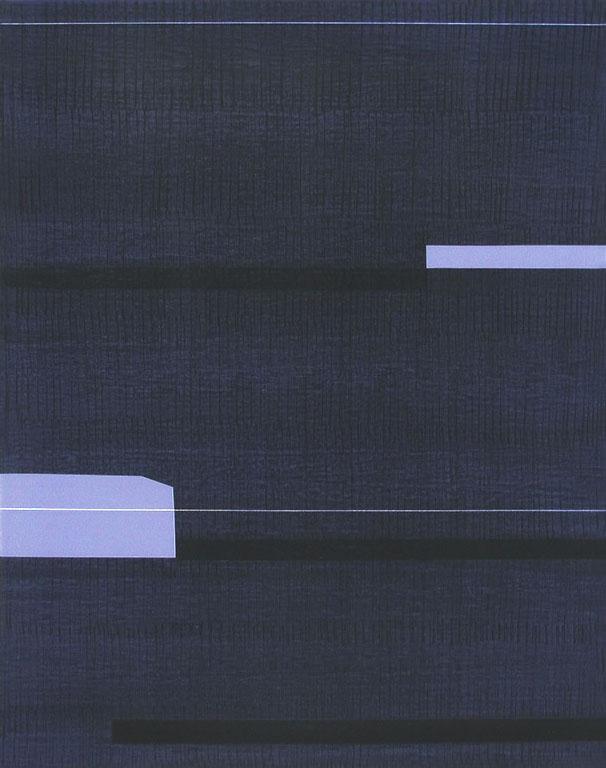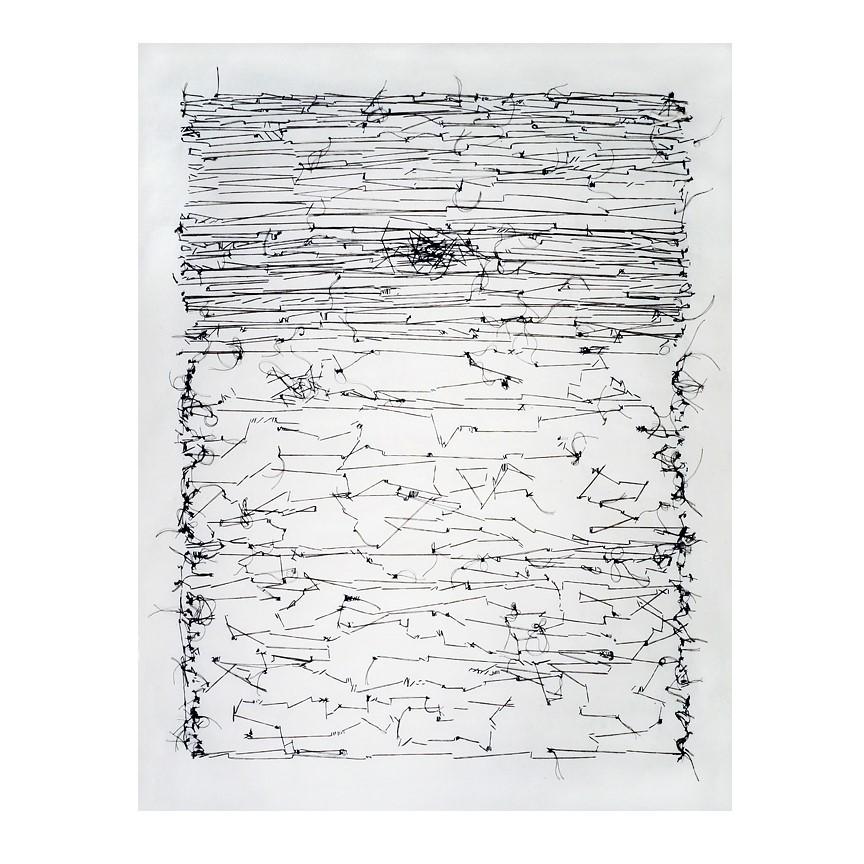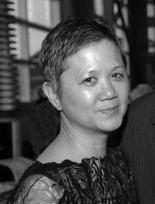She is the recipient of numerous awards and scholarships, including Canada Council Visual Arts Grants, an Elizabeth Greenshields Grant and Federal and Provincial Project and Travel Awards. Her work is exhibited and collected in Canada, Europe, Asia and the United States, with Corporate and Public collections that include National Bank of Canada, Rio Alto Explorations, Concord Pacific, Province of BC, Canada Council Art Bank, Public Works Canada, Department of Foreign Affairs + International Trade. Janice Wong’s family roots trace back through BC history to the mid-1800s. Born in Saskatchewan, she lives and works in Vancouver.
“I am fascinated by the scope and potential of abstraction, especially its relationship to natural phenomenon and its affinity with music. Frequent references include pattern and code that derive from past experience in map-making and early music training. Music terms such as "balance, rhythm, counterpoint, accent" are synonymous with words that define abstract art-making. "Harmony," from the Greek word "harmonia" ("fitting together"), aptly describes how my works are made: from an elementary starting point there are multiple layers that convey a distilled and resonant balance. Pieces may be subtle or dynamic and all retain a quality of stillness and distillation, inviting contemplation and addressing ideas about time, transition, serendipity, sound, notation, rhythm, repetition, relationship, colour and form.”

Acrylic on Panel, Session
What’s your current employment?
Wong: Since 1990, I've been working full time in my studio, and for the past 27 years I've taught part-time in adult education, focusing on drawing, painting and basic printmaking.
A lot of graduates use the ACAD degree as a creative stepping stone. How has what you do evolved since graduation? How did your education at ACAD direct your career?
Wong: I always wanted to have a full time studio practice. Before I studied at ACAD, I spent two years at the University of Saskatchewan, in Saskatoon, and took fine arts classes as electives. I was frustrated by the limited studio time and that was a key reason for my decision to study at ACAD, to be able to experience a full immersion in the studio. After graduation in 1980, aside from ten years of employment in the graphic arts industry, I've been able to maintain that initial desire for full studio immersion.

3rd year painting class critique with Dick Edwards, 1979 (background painting by Amy Gogarty)
What insights did your time at ACAD give you when looking at things? Why does what you learned at ACAD matter?
Wong: I always felt that my strongest faculty was visual, and my time at ACAD supported and nurtured that faculty. The experience fed my curiosity, like an incubator for ideas, experiences and emotions. I am fascinated by visual problem-solving and my time at ACAD encouraged a broad exposure to the possibilities for interpretation and solution. It really was life-changing. I also made life-long friends from my time there, and continue to value the relationships I had with many instructors and students, including those with whom I have lost touch. I think it's a natural outcome to always value such strong experiences from younger, formative years.
In my opinion, the ACAD environment, in the 1970s, had an unspoken weight towards reasoned outcome/solution as opposed to pure process. A simplified interpretation is that visual work had to stand up visually, on its own, without a qualifying statement, and that kind of rigour fit well with my nature…the sentiment that the work should be able to speak for itself.
I also remember an article that one of my instructors gave me, the simplified gist of it was that it's through the personal that we understand and convey the universal, and that sentiment has always been a valuable and honest reminder in moments of hesitation or self-doubt.
If I could change anything, in hindsight, had I the opportunity to do things over again, I would have taken a wider range of studio electives. At the time, the facilities in the various departments—photography, ceramics, textiles, printmaking, sculpture, jewellery, etc.—were so well funded, equipped and supported. When you leave school, it's really difficult to duplicate such facilities, to duplicate the experience you can gain from instructors, equipment, technicians and colleagues.

Monotype, Mended
After graduation, what obstacles did you encounter and how did you overcome them?
Wong: I've often felt at odds with many aspects of contemporary western art practises, and the skill-sets for self-promotion and art-speak are not my strong point. Modesty can be misconstrued as weakness or insecurity, as a lack rather than an asset. And, surety is lauded in contemporary culture. In my experience, the act of painting, the act of engaging in painting, is a suspension, a deference or postponement of surety. As with any kind of work, there are ups and downs on many levels, whether that be with the work itself or the many responsibilities for stewarding it out into the world. It's essential to have sincere, trusting relationships with the people and institutions who represent you, as they are, often, the only body that is publically attached to your work, and there can be ups and downs / trial and error in finding the relationships that work best for you. It's been important for me to define the things that feel fulfilling, the experiences that make me happy. Being able to work abroad and travel, either via residencies or exhibitions, has been personally rewarding. Knowing when to say no, and to set parameters for how I want my work (and, thus, myself) to be represented has also been really important, even if it seems like a setback to decline something that is initially portrayed as an opportunity.

Monotype, Mended 2
What would you like to be recognized for?
Wong: That's a difficult question. I was raised in a family with a stereotypical but sincere Asian-based humility and modest sentiments, so it always feels a bit presumptuous to make this kind of definition or distinction. I'm comfortable saying I value the experience of looking, of noticing things, the subtle relationships between things, the curious, exceptional and surprising "commonplace." And, so I want my work to reaffirm these qualities, conveying moments as intimate events, making work that asks for a different quality of attention, a specific way of being present. I like to think that my work invites contemplation, that it affirms the value of subtlety and distillation. There are three Asian words that I often think about, single words that encompass whole concepts. They are the language-based epitomy of "distillation," with their ability to condense very subtle, wider poetic sentiments into a single word. For example, Suki, which is Japanese for "the space between", which I respond to as a unique poetic and visual regard for spaces and states (be they physical, intellectual or emotional) of "in between." (the only English equivalents I can think of are "liminal" and the precise but blunt "interstice"); and "Shen" a Chinese word that translates to "wonder, great wonder" and "Wabi" which is Japanese for the clarity of ordinary substance, seen for itself, in its true quality. If, through my work, I've encouraged someone to go about their daily life, noticing such subtle attributes, intimate and often playful commonplace wonders, then I am happy.

Above: This paper and thread piece was used as both the front and back covers for German musician, Nils Frahm's "solo" album. The piece was completed at the SIM Residency in Reykjavik, Iceland.
Below: First Image - Gampi paper and thread, "Land:Listen" front view, Second Image - Gampi paper and thread, "Land:Listen" back view



photo credit: Sandra Sawatzky-Cariou, 1979
See Janice's Instagram
